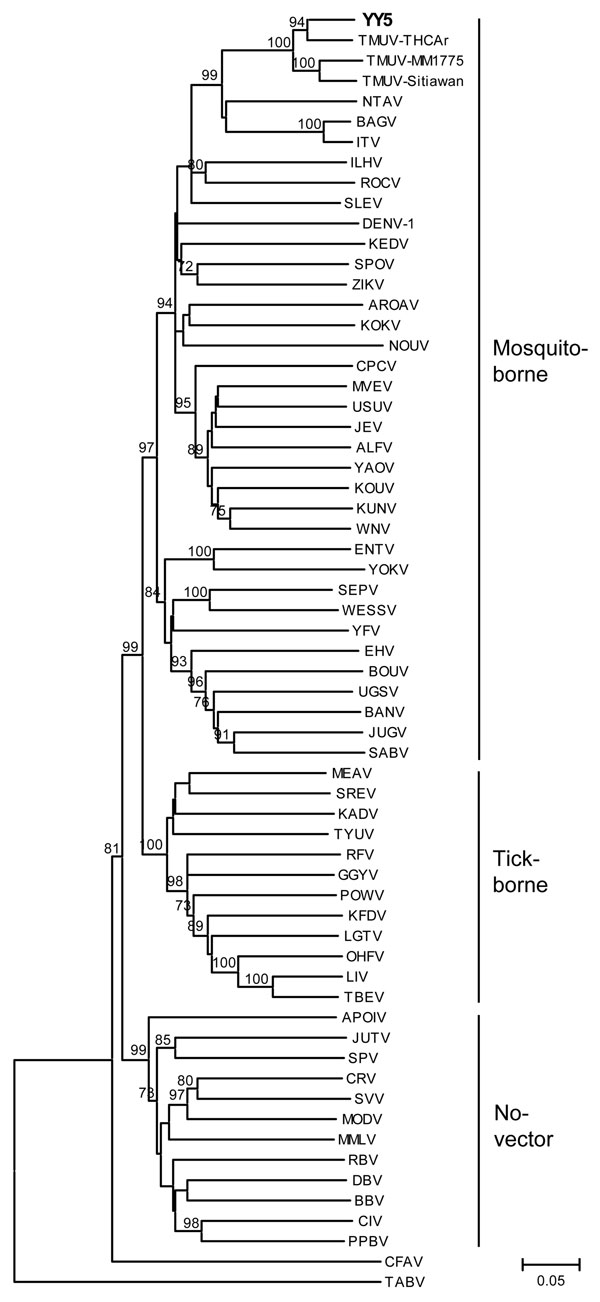Volume 17, Number 10—October 2011
Dispatch
Tembusu Virus in Ducks, China
Figure 2

Figure 2. Phylogenetic analysis of isolate YY5 (in boldface) from an ill Shaoxing duck in the People’s Republic of China and selected other flaviviruses obtained by using an ≈1-kb nt sequence in the nonstructural 5 genomic region. The tree was constructed by the neighbor-joining method of MEGA (7). Numbers at nodes indicate bootstrap percentages obtained after 1,000 replicates; only bootstrap values >70% are shown. Scale bar indicates genetic distance. The sequences used in the phylogenetic analysis are as follows: AF013374, Gadgets Gully virus (GGYV); AF013385, Kyasanur Forest disease virus (KFDV); M86650, Langat virus (LGTV); Y07863, louping ill virus (LIV); AF013393, Omsk hemorrhagic fever virus (OHFV); L06436, Powassan virus (POWV); AF013398, Royal Farm virus (RFV); U27495, tick-borne encephalitis virus (TBEV); AF013380, Kadam virus (KADV); AF013386, Meaban virus (MEAV); AF013403, Saumarez Reef virus (SREV); AF013410, Tyuleniy virus (TYUV); AF013362, Aroa virus (AROAV); NC_001477, dengue virus 1 (DENV-1); AF013382, Kedougou virus (KEDV); AF013367, Cacipacore virus (CPCV); U15763, Japanese encephalitis virus (JEV); AF013384, Koutango virus (KOUV); AF013360, Alfuy virus (ALFV); AF013389, Murray Valley encephalitis virus (MVEV); AF013416, St. Louis encephalitis virus (SLEV); AF013412, Usutu virus (USUV); M12294, West Nile virus (WNV); D00246, Kunjin virus (KUNV); AF013413, Yaounde virus (YAOV); AF013383, Kokobera virus (KOKV); AF013363, Bagaza virus (BAGV); AF013376, Ilheus virus (ILHV); AF013397, Rocio virus (ROCV); AF013377, Israel turkey meningoencephalomyelitis virus (ITV); AF013392, Ntaya virus (NTAV); AF013408, Tembusu virus strain MM1775 (TMUV-MM1775); AF013409, TMUV strain THCAr (TMUV-THCAr); AB026994, TMUV strain Sitiawan (TMUV-Sitiawan); AF013415, Zika virus (ZIKV); AF013406, Spondweni virus (SPOV); L40951, Banzi virus (BANV); AF013364, Bouboui virus (BOUV); AF013372, Edge Hill virus (EHV); AF013378, Jugra virus (JUGV); AF013400, Saboya virus (SABV); AF013404, Sepik virus (SEPV); AF013411, Uganda S virus (UGSV); EU707555, Wesselsbron virus (WESSV); X03700, yellow fever virus (YFV); AF013373, Entebbe bat virus (ENTV); AF013414, Yokose virus (YOKV); AF013361, Apoi virus (APOIV); AF013370, Cowbone Ridge virus (CRV); AF013379, Jutiapa virus (JUTV); AF013387, Modoc virus (MODV); AF013401, Sal Vieja virus (SVV); AF013402, San Perlita virus (SPV); AF013365, Bukalasa bat virus (BBV); AF013368, Carey Island virus (CIV); AF013371, Dakar bat virus (DBV); AF013388, Montana myotis leukoencephalitis virus (MMLV); AF013394, Phnom Penh bat virus (PPBV); AF013396, Rio Bravo virus (RBV); M91671, cell fusing agent virus (CFAV); NC_003996, Tamana bat virus (TABV); and EU159426, Nounané virus (NOUV). The nucleotide sequence of isolate YY5 used in the phylogenetic analysis has been deposited in GenBank under accession no. HQ641390.
References
- Dougherty E III, Price JI. Eastern encephalitis in white Pekin ducklings on Long Island. Avian Dis. 1960;4:247–58. DOIGoogle Scholar
- Linssen B, Kinney RM, Aguilar P, Russell KL, Watts DM, Kaaden O, Development of reverse transcription-PCR assays specific for detection of equine encephalitis viruses. J Clin Microbiol. 2000;38:1527–35.PubMedGoogle Scholar
- Bondre VP, Sapkal GN, Yergolkar PN, Fulmali PV, Sankararaman V, Ayachit VM, Genetic characterization of Bagaza virus (BAGV) isolated in India and evidence of anti-BAGV antibodies in sera collected from encephalitis patients. J Gen Virol. 2009;90:2644–9. DOIPubMedGoogle Scholar
- Baillie GJ, Kolokotronis SO, Waltari E, Maffei JG, Kramer LD, Perkins SL. Phylogenetic and evolutionary analyses of St. Louis encephalitis virus genomes. Mol Phylogenet Evol. 2008;47:717–28. DOIPubMedGoogle Scholar
- Bakonyi T, Gould EA, Kolodziejek J, Weissenböck H, Nowotny N. Complete genome analysis and molecular characterization of Usutu virus that emerged in Austria in 2001: comparison with the South African strain SAAR-1776 and other flaviviruses. Virology. 2004;328:301–10. DOIPubMedGoogle Scholar
- Kuno G, Chang GJJ, Tsuchiya KR, Karabatsos N, Cropp CB. Phylogeny of the genus Flavivirus. J Virol. 1998;72:73–83.PubMedGoogle Scholar
- Tamura K, Dudley J, Nei M, Kumar S. MEGA4: Molecular Evolutionary Genetics Analysis (MEGA) software version 4.0. Mol Biol Evol. 2007;24:1596–9. DOIPubMedGoogle Scholar
- Kono Y, Tsukamoto K, Hamid MA, Darus A, Lian TC, Sam LS, Encephalitis and retarded growth of chicks caused by Sitiawan virus, a new isolate belonging to the genus Flavivirus. Am J Trop Med Hyg. 2000;63:94–101.PubMedGoogle Scholar
1These authors contributed equally to this article.